Table of Contents
Bee Shrimp Overview
Rearing shrimp is the latest craze in the aquarium hobby, perhaps due to the beauty and ease of caring for the aquarium animal. While there are various types of freshwater shrimp available for the aquarium hobby, the Bee Shrimp certainly is one of the more popular ones.
This kind of shrimp makes a great addition to the aquarium by offering a stunning display. This shrimp is not for the first-timers in the hobby because it is pretty demanding and requires the care of an experienced aquarist. The animal is said to be a native of China, and it can live a maximum of just 18 months.
The bee shrimp in the wild are known to live in rivers with soft water; therefore, when they are to be kept in captivity, their habitat must be replicated with that in the wild. It is a peaceful shrimp and will thus make a great addition to any given tropical aquarium. With proper care in the aquarium setting, the shrimp can look amazing in the tank and work as the center of dominance in your aquarium.
If you consider adding bee shrimp to your aquarium, keep in mind that you need to be highly cautious of the care and the kind of efforts you are putting into growing them in captivity.
| Information Chart | Bee Shrimp |
| Scientific Name | Caridina Cantonensis |
| Family | Atyidae |
| Care level | Intermediate to Advanced |
| Temperament | Peaceful, non-territorial |
| Color | Black, yellow, red stripes transversely on the body |
| Lifespan | 1.5 to 2 years |
| Size | Up to 1 inch |
| Diet | Omnivore |
| Minimum tank size | 10 gallons |
| Water conditions | Clean water with sponge filter |
| Tank mate compatibility | Peaceful, same-species |
Appearance of Bee Shrimp

There are many variations of the bee shrimp, but the black bee shrimp, sometimes referred to as crystal bee, is the original one. The female shrimp of this species is usually more significant than the male shrimp. The shrimp usually exhibits white and dark brown stripes on its body in a zebra-like manner. However, other varieties may show red and black stripe patterns, all blue, all-black, and white.
Besides their original color and appearance, aquarists are now cross-breeding bee shrimps with other varieties of shrimps to make more colorful variants. Some of the common examples of such hybrid breeding include:
- Crystal red shrimp
- Crystal black shrimp
- Blue bolt shrimp
- Golden bee shrimp
- Red bee shrimp
- Red tiger shrimp
- Panda shrimp
- King Kong and several other color morphs
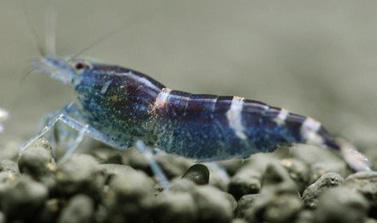
Amidst all the available variants, red bee shrimp is one of the most commonly found variants in the natural habitat. One of the unique features of their appearance lies in their bodies’ bright red and brown traverse stripes. There are usually 2-4 bands running around the back of their body.
However, if you consider buying these bee shrimps from the market, the black and yellow striped variants are the more commonly found options.
Another marker that influences their appearance is stress. If the bee shrimps are faced with any kind of stress from the environment, they will shut down, and their color becomes a lot duller than standard.
Lifespan of Bee Shrimp
The typical lifespan of a bee shrimp is 1.5 to 2 years in captivity. Typically, the lifespan depends on the water conditions they are kept in and the tank mates. If they are consistently under stress or have contracted any kind of bacterial or parasitic infection, you can expect them to die prematurely.
Bee Shrimp Size
The bee shrimp typically grows up to 2-3 cm or 1 inch. This shows that these tiny invertebrates are extremely small and won’t respond well when kept in a community tank with larger fishes that view them as food. They typically grow well in the same-species tanks or with other shrimp varieties of their size.
Natural Habitat and Origin
It is a freshwater shrimp that likes to inhabit small rivers or streams with slow-moving water. It is native to China, but some reports are also found naturally in Taiwan. They are predominantly found in abundance in Nan’ao island, Guangzhou, Yangjiang of Guangdong Province, Hong Kong, and northern Vietnam.
The shrimp inhabits soft waters and will not survive in hard water, so the preferred water parameter should be between KH 0 and 2. Just like many other varieties, the bee shrimp only thrives in clean water. Even in its natural habitat, this is usually found in pristine waters because it will quickly die in dirty waters or heavily polluted streams or rivers.
In the wild, the shrimp inhabits waters that have temperatures that are below 26°C. This means that it will be required to keep it within this temperature range even in captivity.
These shrimps are countered as endangered in their natural habitat, primarily due to the aquarium trade, pollution in the water bodies, and consistent habitat fragmentation.
Bee Shrimp Care and Tank Set-up
This certainly is not the perfect choice of shrimp for a novice in the hobby because it is very demanding and not as hardy as some other shrimps. First, it needs spotless water for it even to survive, and this is something that can best be done by the more experienced aquarists.
In addition to the water parameters above, you could also have caves or some hiding place because they are prey animals and thus like to hide to prevent easy detection by predators. You can have live freshwater plants in the aquarium that will also help provide hiding places and help expel the buildup of ammonia from the water, thus improving the quality. You might want to consider adding low-light aquatic mosses like the java moss to help shelter the shrimp there.
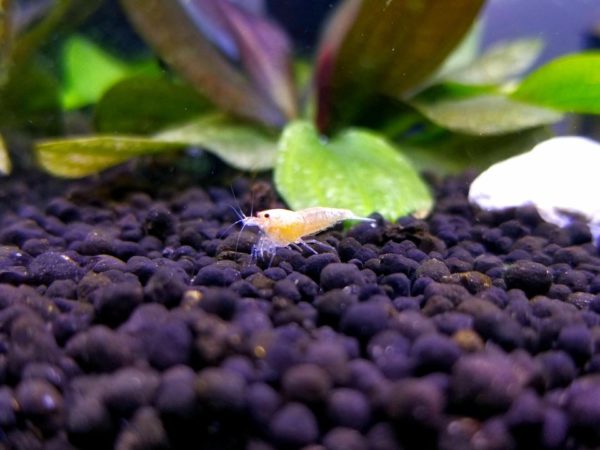
Ensure that you keep the water temperature low for more oxygen to dissolve in the tank water. The shrimp does well in well-oxygenated waters.
Bee Shrimp Tank Size and Specifications
As mentioned before, housing a bee shrimp in your aquarium requires expertise and knowledge. If you are not well acquainted, you will make mistakes that will result in premature death.
Bee shrimps require adequate tank size with unique water parameters that you need to follow and be mindful of. Not only are they susceptible to ammonia and nitrate, but they also require essential tank care that you need to be mindful of.
Optimum Tank Size for Bee Shrimp
The recommended tank size (minimum) for Bee Shrimp is 5 gallons. However, most experienced aquarists will suggest that you at least have a 10 gallons tank in case you want to add more shrimps to it.
Besides the accommodation factor, having a larger tank also stabilizes the remaining water parameters, applying for almost every kind of shrimp you try to grow in captivity.
Since bee shrimps are extremely sensitive to changing water conditions, housing them in large tank rules out those complications for good. So, if you are considering a standard tank size for these shrimps, 10 gallons is deemed to be ideal.
Filter Type
Unlike what you might assume, bee shrimps need clean water to survive. They are susceptible to higher nitrate and ammonia levels, so a good-quality filter must be integrated into the tank.
However, one issue with adding filters to the tank is the size of the shrimps. Since they are such small creatures, any kind of high-speed and extremely powerful water filter has the tenacity to put them into it.
So, stick to sponge or matten filters for such tanks. Not only do they do the job right by keeping the water clean, but they are also pretty easy to maintain and clean, which is enough of a reason why you need to integrate them into your fish tank.
Also, since the Caridina cantonensis shrimps are naturally found in mountainous regions, good water aeration is crucial for survival.
Substrate
The bee shrimps rely on a neutral water condition, so adding good quality active substrate in the tank regulates the pH of the water. If you are confused about what an active substrate is, they are responsible for lowering the pH of the water to prevent the risk of the water getting too alkaline. Your breeder would guide you about the best substrate that you should add to the tank.
Water Parameters for Bee Shrimp
As we said before, bee shrimps come with a list of specifications for their care. So, if you are not experienced with shrimps, educate yourself first, and only then should you consider adding them to the tank.
That said, one of the crucial parts to housing bee shrimp is the water parameters. From the temperature to the pH, the aquarist needs to follow caution to ensure optimal health.
Water temperature
The ideal water temperature for bee shrimp is between 20 – 24 °C (68 – 74 °F). This is indicative of the fact that these small shrimps do prefer colder temperatures over warmer ones.
However, one good thing about housing bee shrimps in your home aquarium is that they don’t necessarily have drastic health altercations to water temperature fluctuations. Some can withstand colder and warmer temperature settings than the standard range.
Also, one unique feature about bee shrimp (or any other shrimp) is that they are poikilothermic, which means that they can adapt their body temperature depending on their surroundings.
Besides all that, another factor worth considering about the water temperatures is that while warmer temperatures aid with breeding and growth, extremely high temperatures shorten their lifespan.
pH Level
The perfect water pH level for bee shrimp is between 6.0 to 6.8. In most conditions, they do prefer living in slightly acidic water conditions. However, they also thrive in neutral water conditions as well.
Water Hardness
The ideal water hardness level for bee shrimp is between 3 – 6 GH.
Bee Shrimp Tank Landscape
With the basic tank setup and water parameters out of the way, we also must focus on the landscape. We have briefly discussed substrate and the filter type, but what about the rest? What about the plants and the decorations?
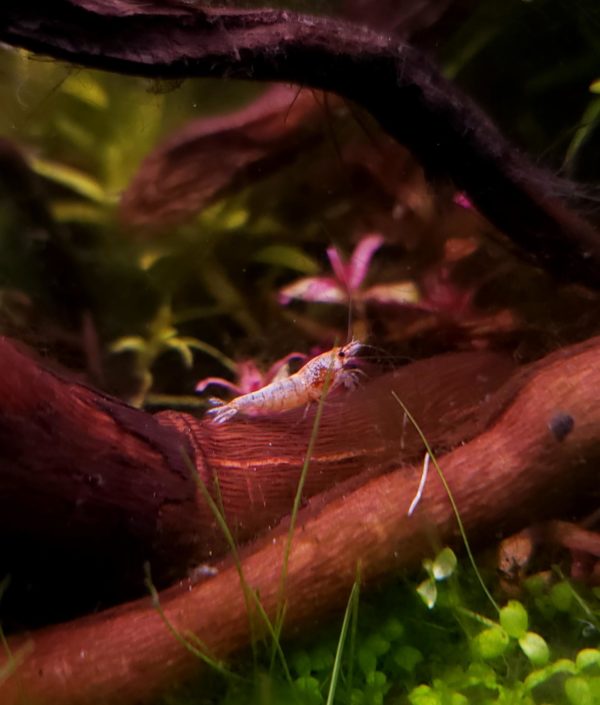
Well, this is the section of the article that focuses on that.
Plants and Decorations for Bee Shrimp Tanks
When it comes to the additional tweaks to the bee shrimp tank, there are a few essential additions that these tiny creatures will appreciate.
The addition of driftwood and live aquatic plants is often suggested to encourage algae and biofilm growth. These small knick knacks also allow the shrimps to have enough hiding and relaxing spots around the tank.
Also, these hiding spots allow the shrimps to undergo their molting process without feeling threatened by their surroundings.
Before adding any kinds of decorations or foreign articles to the shrimp tank, make sure you quarantine those items for at least a few days before introducing them to the tank.
Also, for substrate, consider adding viable products like aqua soil, Fluval plants, etc.
Lighting for Bee Shrimp Tanks
Light isn’t quintessential for a bee shrimp tank. If you are adding live plants to the tank, add lighting to help with their growth in the plants.
Feeding Bee Shrimp
It is a filter feeder, but it is also accustomed to eating small pieces of algae and decaying vegetation in the wild. In an aquarium setting, the shrimp diet needs to be diversified to help keep it well-nourished.
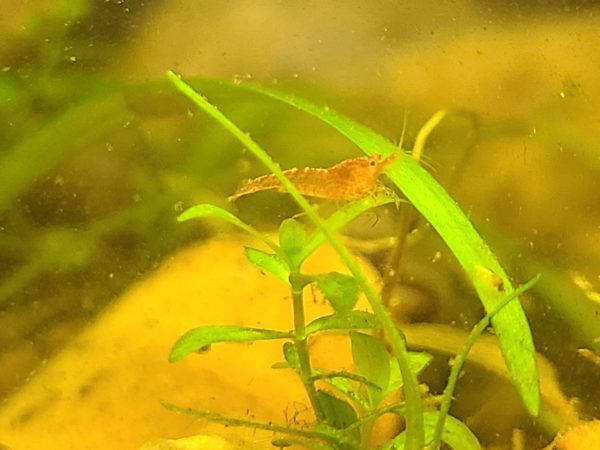
Below is a list of some quality shrimp foods that you can offer your shrimp in the tank:
- Sinking shrimp pellets
- Crushed flake foods
- Small frozen foods i.e., daphnia, mini bloodworm, and baby brine shrimp, etc
- Vegetables such as spinach or courgette or even kales
In addition to the above list, you could also include Indian almond leaves. The leaves will help form biofilm as they rot slowly, thus acting as an excellent food source for the shrimp. This will also help in the maintenance of a low pH in the aquarium.
Another important tip is that once you have offered food to your shrimp, ensure that you remove any leftover food immediately from the tank. This will help to keep the water quality intact.
Behavior and Temperament of Bee Shrimp
If you consider adding the Caridina cantonensis species into a community tank, be assured that they won’t cause any issues in the tank. They have a peaceful temperament and are pretty harmless.
These small shrimps prefer living in larger groups, which means that you need to keep them in multiples and not alone. Even in the same species tank, keep them in groups instead of 2-3. They can do pretty well in smaller tanks, too, since they are not that territorial.
Also, unlike other aquatic creatures, they are nocturnal. This means that you won’t find them being active during the daytime. Instead, they come out during the nighttime or preferably after dusk, and their activity levels decline as the sun rises.
The primary reason behind their nocturnal behavior is their safety. Being active during the night enables them to keep themselves safe from vicious predators in the tank.
When active, these small shrimps move around inside the tank in search of food. So, you will find them zooming around the tank, especially in the bottom layer, scrambling through the substrate, trying to look for food.
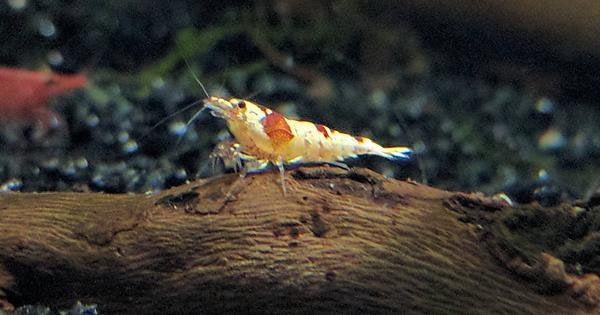
They rarely stay in one place during their active period, so you will generally find them moving around the tank with no stop.
Are bee shrimp Lone or Societal?
The bee shrimps are societal and like to stay in groups to keep themselves safe and comfortable in the tank.
Bee Shrimp Tank Mates
Since the bee shrimp is tiny, sometimes even measuring less than an inch, your ideal situation would be housing them in a same-species tank. This reduces the stress on the bee shrimps and keeps them healthy to live up to their standard lifespan.
However, that doesn’t mean that they can’t be kept in community tanks. You just need to be extremely careful of the species you pair them with. Typically, larger and aggressive fish species are out of the question because they will gobble down the bee shrimps when you introduce them to the tank.
These shrimps best pair with dwarf shrimps because of their similar temperament. Since both are quiet and peaceful, housing them together reduces the risks of attacks and stress in the tank. Also, they both require identical water parameters, which makes it easier for the aquarists to maintain.
Best Tank Mates for Bee Shrimp
- Crystal shrimp
- Bamboo shrimp
- Tangerine tiger shrimp
- Blue bolt shrimp
- Ramshorn snails
- Nerite snails
- Malaysian trumpet snails
Bad Tank Mates for Bee Shrimp
- Crayfish
- Freshwater crabs
- African dwarf frogs
- Large and aggressive fishes
If you are confused about who to house them with, it is always ideal to consult about the same with the breeder you are getting the shrimps from.
Breeding Bee Shrimp
Breeding the Shrimp is not an easy task and requires an expert in shrimp aquarium breeding. The one major setback in breeding the bee shrimp in the tank is that the offspring usually turns out to be weak in most cases. This usually makes survival for the juvenile shrimp complicated.
To get successful with breeding the Bee Shrimp, proper identification of the sexes is vital. The female is usually a little larger than the male and also has a deeper abdomen. It is the female shrimp that will initiate the breeding process for the species. The breeding process, therefore usually starts with the female releasing pheromones in the water, thus signaling the male that time for mating is ready.
The male will then approach the female, and a bizarre dancing and swimming act will ensue. It is the female that carries the eggs underneath her abdomen until they hatch to produce juvenile shrimp. It is important to note that all the juvenile shrimp will not survive at a temperature that is more than 76 degrees Fahrenheit. Therefore, it is imperative to keep the tank water below this temperature if any successful breeding is to be achieved.
Bee Shrimp Breeding Level
The breeding level in bee shrimp is Easy to Intermediate.
Bee Shrimp Sexual Dimorphism
Distinguishing the male and female bee shrimps is not as complicated as people think. Following are some of the factors that can help determine:
- The more giant shrimps are females, and the makes are smaller.
- The females are generally wider around the abdomen to help carry the eggs, lay them, and protect them.
- The male shrimps are comparatively smaller and thinner.
- The saddle is often hard to spot in the female bee shrimps due to their vibrant coloration but is easily spotted in males.
Bee Shrimp Disease and Treatment
Unless you are breeding your bee shrimps, knowing about the history of the shrimp is extremely difficult.
Sometimes, most of the diseases are prevalent in in-bred species. So, when you are getting them from the commercial breeders, ask them about their history and breeding practices.
If the shrimps are diseased, there is no point buying and housing them because they will die reasonably quickly.
Are Bee Shrimps Right for You?
Bee Shrimps are a fantastic addition to the tank, despite the challenges they come with. Typically, they are ideally suggested to the expert aquarists who have prior experience handling shrimps and similarly challenging species.
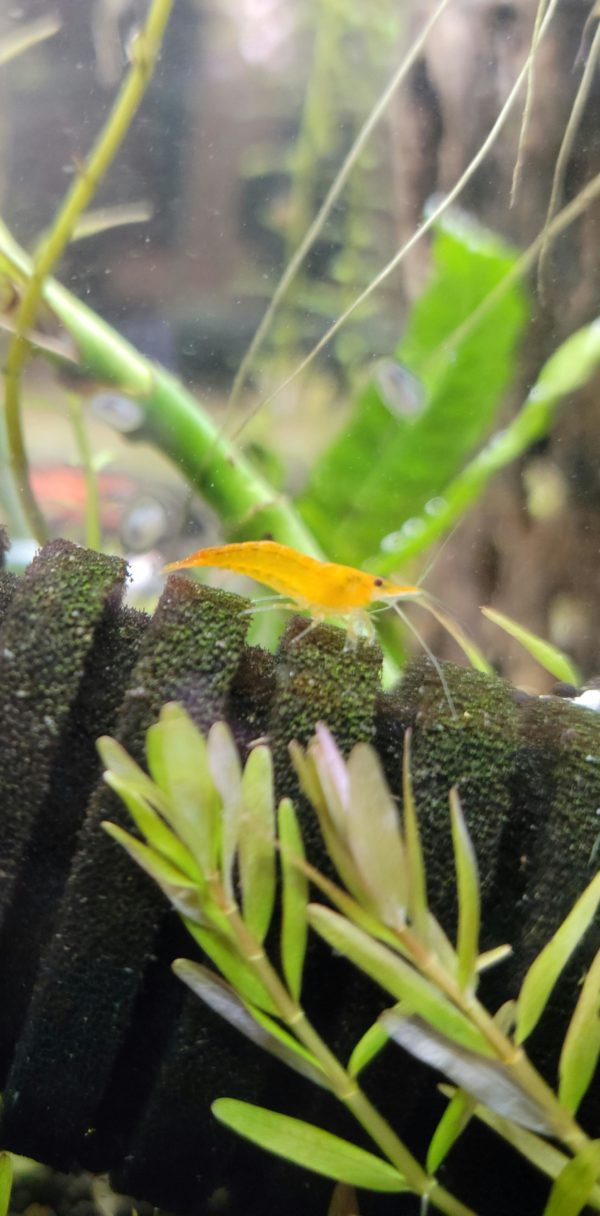
However, if you are up for the challenge and want to house them in your home aquarium, we’d recommend you go for it without further questions.
FAQs
How often do Bee Shrimps Molt?
Like any other shrimp species, even in bee shrimps, molting is a very common procedure that they undergo. They shed the exoskeleton during this process as their body grows out of the shell. An adult and fully grown bee shrimp will molt every 4-6 weeks to accommodate their growing body. During molting, the shrimp indulges in less activity and try to hide in the caves and plants till their outer shell grows back.
Are bee shrimps Easy to Keep?
As we have mentioned throughout the article, bee shrimps require extra attention and care. Typically, you need to have prior experience in taking care of shrimps before considering housing them in the home aquarium.
Do Bee Shrimps lay Eggs?
Unlike most other types of aquatic species, shrimps (in general) carry the eggs in the underside of their body. These are then laid and fertilized by the male shrimps, and the fry is born from the same.
Conclusion
As you can imagine, having bee shrimps in your aquarium will require a lot of maintenance and care. However, if you are confident that you can provide the necessary care, the bee shrimps will give you much joy in this hobby. Best of luck!
If you have any further queries about taking care of bee shrimp or their breeding practices, leave a comment, and we’ll get back to you.
No related posts.
